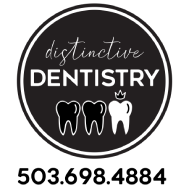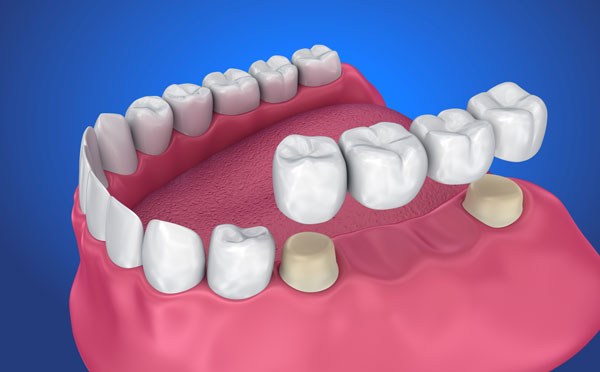The use of dental bridges and crowns is among the many techniques used in Restorative Dentistry. Restorative Dentistry is a branch of dentistry concerned with the replacement and restoration of missing or damaged teeth. The goal is not only to improve the patient’s smile but also to prevent several oral and dental problems from occurring in the absence of treatment. Dental restoration protects the rest of the teeth in your jaw by keeping them from migrating into the space of missing teeth and becoming loosened or misshapen. A good smile also has a tremendous psychological impact, improving your self-esteem and confidence.
A dental bridge is a fixed dental restoration (a fixed dental prosthesis) used to replace one or more missing teeth by joining an artificial tooth definitively to adjacent teeth or dental implants. Dental bridges are of different types and are classified according to durability, material, and design.
The durability of a dental bridge can either be temporary (also known as “provisional” or “interim’”) or permanent.
The material of a dental bridge can be made out of 1) a metallic base that includes metal alloys or noble metal; or 2) a non-metallic base that is resin veneered, a fiber-reinforced composite, porcelain fused to metal (PFM), or ceramics.
The design of a dental bridge refers to the different types available, including a conventional dental bridge, a Maryland dental bridge (adhesive bridges), a cantilever bridge, or an implant-supported bridge.
A dental crown is a tooth-shaped “cap” placed over a tooth that has been damaged. The crown covers the damaged tooth to restore its shape and size, strength, and improve its appearance. When cemented into place, a crown encases the entire visible portion of a tooth that lies at and above the gum line.
A dental bridge provides many benefits to patients, including:
- Restoring a natural smile
- Restoring the natural ability to chew
- Enhancing communication
- Recovering the form of teeth and hence, face and facial features will also remain in proper form.
A dental crown offers many benefits to patients, including:
- Protecting a weak tooth from breaking.
- Holding together parts of a cracked tooth.
- Restoring an already broken tooth or a tooth that has been severely worn down.
- Covering and supporting a tooth with a large filling.
- Holding a dental bridge in place.
- Covering misshaped or severely discolored teeth.
- Covering a dental implant.
- Making a cosmetic modification.
- Restoring the ability to chew and speak properly.
- Maintaining the shape of your face.
- Distributing the forces in your bite properly by replacing missing teeth.
- Preventing remaining teeth from drifting out of position.
For children, a crown may be used on primary (baby) teeth to save a tooth that has been so damaged by decay that it can’t support a filling; to protect the teeth of a child at high risk for tooth decay, especially when a child has difficulty keeping up with daily oral hygiene; and to decrease the frequency of general anesthesia for children unable to cooperate with requirements of proper dental care because of age, behavior, or medical history.
During your consultation, Dr. Klemann will go over your medical and dental history and examine your mouth and the area being considered for bridgework. X-rays may also be taken as well as a cast of your teeth.
Following this exam, Dr. Klemann will assess whether or not the teeth that would hold the bridge would need some work before the bridge is made. For example, some patients may need a root canal on one of the teeth before the bridge is started.
Once any foundation work has been completed, Dr. Klemann will schedule you for an appointment for bridgework.
Getting a dental bridge is typically a two-appointment process.
Your first appointment is for preparing the abutment teeth for the crowns that will hold the bridge in place. Dr. Klemann will
- Administer a local anesthetic to numb the tooth and surrounding tissue.
- Prepare abutment teeth, removing some of the enamel to make room for the crown to be placed over them.
- Take preliminary impressions of your teeth to get a model of them to send to the dental lab.
- Reshape (file down) teeth to the required size to make space for the bridge. Depending on the size of the bridge, this could take up to an hour to do.
- Make a temporary bridge to wear to protect the exposed teeth and gums while the dental lab makes the permanent bridge. The dental lab usually takes 5-7 days to complete the fabrication of your dental bridge.
After your first appointment, Dr. Klemann will schedule your second appointment for cementing the permanent bridge into place.
During that appointment, Dr. Klemann will
- Remove the temporary bridge.
- Check the new bridge and adjust as needed for a proper fit and bite.
- Cement the bridge into place.
Note that depending on the type of bridge the patient is getting, multiple visits may be required to check the fit of the metal framework and bite before permanently cementing the bridge into place.
While dental bridges and crowns can last a lifetime, they do sometimes come loose or fall out. The most important step you can take to ensure your bridge or crown’s longevity is to practice good oral hygiene.
- Keep your gums and teeth healthy by brushing with fluoride toothpaste twice a day and flossing daily.
- See your dentist or hygienist regularly for checkups and professional cleanings.
- Avoid chewing hard foods and ice to prevent damage to your new bridge or crown.
Dental bridges and crowns, on average, can last about 15 years if you take proper care of them.
If you are interested in dental bridges or crowns, call Distinctive Dentistry at (503) 698-4884 to schedule an appointment with Dr. Klemann. For your convenience, you may also schedule an appointment online.




